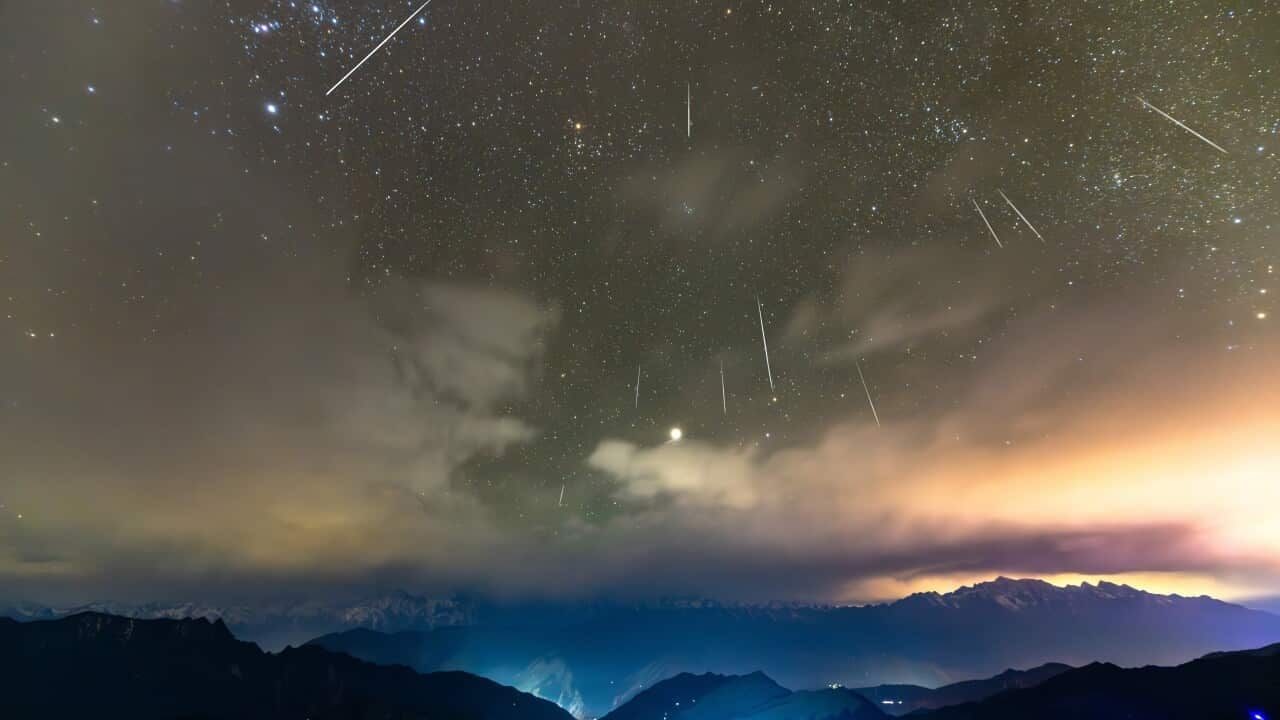Alert the stargazers in your life, because we're about to be treated to one of Australia's best meteor showers this weekend.
The Geminid meteor shower occurs annually when the Earth moves through the debris of the 3200 Phaethon asteroid, which is set to peak early on Saturday morning.
It's typically the meteor shower that will give you the most meteors per hour in Australia.
But this year, the moon might dampen our celestial plans, leaving only a small window of a few hours to best watch the shower.
LISTEN TO

Delving deep into the mystery of neutron stars
SBS News
11/07/202404:57
Jonti Horner, professor of Astrophysics at the University of Southern Queensland, said while the Geminid meteor shower is often one of the best showers in Australia, this year's conditions mean it won't be as good as usual.
"In a normal year, the Geminids are the best shower of the year, very comfortably," he told SBS News.
"But this year will be the worst operation of the Geminids in a while because of the full moon."
Perfect conditions for meteor shower viewing are moonless nights out in the countryside where there's no light pollution. But as it's a full moon this weekend, visibility will be poorer, even if you head an hour out of the city.

Source: SBS News
This means that the smaller meteors, which produce less light, won't be as easily visible to the naked eye. But you might still be able to see the bigger parts of the meteor, which burn brighter due to their size.
A small window of opportunity
But it's not all bad.
There's a small window of opportunity to see the dozens of meteors in the sky early on Saturday morning after the moon sets.
"You won't see as good a display as you would have last year until the moon has almost set," Horner said.
"The moon doesn't have to be perfectly set, but as the moon gets closer to setting, the sky will get darker, and you'll start to see more of the meteors."
LISTEN TO

Spectacular Melbourne 'meteor' turns out to be space junk
SBS News
08/08/202306:09
When is the best time to watch the Geminid meteor shower?
Prep the coffee because it will be either a very late night or a very early morning.
You'll want to head out when the moon has set, which might be between 3 and 4am, depending on where you live.
"I would head out about half an hour before the moon sets and try and stay out for at least an hour," Horner recommended.
"At that time of the night with the moon out of the way, that's when you'll get the best show."
Moon set times across Australia
- Sydney – 4am
- Melbourne – 4.14am
- Brisbane – 3.08am
- Adelaide – 4.18am
- Canberra – 4.03am
- Darwin – 4.43am
- Hobart – 3.16am
- Perth – 3.31am
What can I expect to see during the Geminid meteor shower?
The magic number of meteors in the perfect shower with the right location and conditions might reach 150 meteors an hour.
But this all depends on when you're viewing them, where you live, and what kind of conditions you're up against.
The higher up in Australia you live, the more meteors you'll see.
Darwin will be the premium viewing spot with about 48 estimated meteors per hour on Saturday morning. Brisbane will reach an estimated 37 meteors per hour, while Perth will get 32.
The further south you get, the fewer meteors. Sydney will average at 27 an hour, Melbourne at 22, Canberra at 25, Adelaide at 27, and Hobart at 17.
It also depends on when you're viewing the shower. Saturday morning will be the best night to watch the shower, followed by Friday morning.
While you can watch the shower outside of these times, the further away you get from the Saturday morning peak, the fewer meteors you'll see.
Tips for the best Geminid viewing experience
While it might not be as good of a shower as previous years, Horner recommends a few things that will help increase your chances of catching a few meteors in the sky.
- Look in the right direction: Try to look west of due north. A good signpost can be locating the bright red Mars in the sky and then placing it slightly left in your vision.
- Reduce light pollution: If possible, try to get away from the city to reduce your light pollution. Horner also recommends picking a spot where you can slightly block out the moon to reduce natural light pollution. This might mean setting up behind a building or a tree.
- Arrive 30 minutes prior and stay for at least an hour: Try to arrive 30 minutes before the moon is setting and sit back, relax and enjoy the show (ideally for an hour).
- Take something to lie on: Protect your neck by bringing a blanket and cushions to lie on or a chair that folds back further.
- Take a friend: Horner said meteor showers are best enjoyed with company. "It's always more fun if you've got someone to share it with."
- Plan ahead: While this year might not have optimum conditions, Horner said next year's Geminid meteor shower will be almost perfect as the moon will be out of the way. Consider this your practice attempt for next year — and consider booking a camping trip around it.









